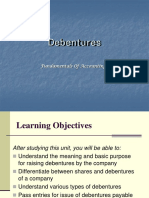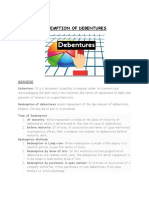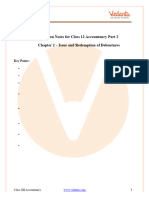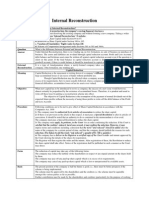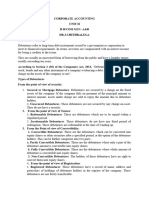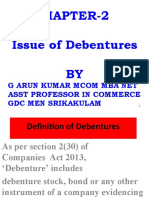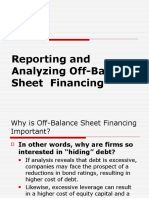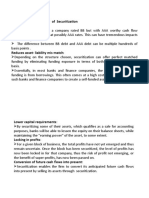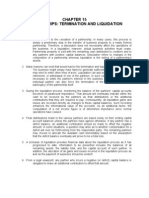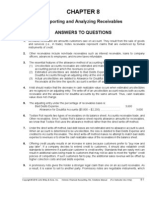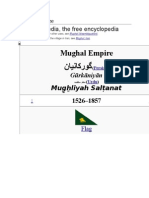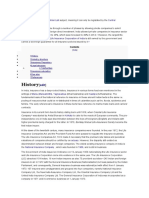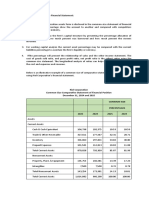Redemption of Debentures
Redemption of Debentures
Uploaded by
Hitesh MendirattaCopyright:
Available Formats
Redemption of Debentures
Redemption of Debentures
Uploaded by
Hitesh MendirattaOriginal Description:
Copyright
Available Formats
Share this document
Did you find this document useful?
Is this content inappropriate?
Copyright:
Available Formats
Redemption of Debentures
Redemption of Debentures
Uploaded by
Hitesh MendirattaCopyright:
Available Formats
PROJECT REPORT ON
REDEMPTION OF DEBENTURES
Submitted By: B.Com (P), First Year
Submitted to
REDEMPTION OF DEBENTURES Meaning Redemption means repayment. Redemption of debentures refers to discharge of liability on account of debentures by repaying the due amount to the debentures-holders. On the expiry of the period at which the debentures have been issued, redemption or repayment is made depending upon the terms and conditions of their issue. They can be redeemed even before the expiry of the fixed term. The Articles of Association and terms of issue of debentures govern the method of redemption to be adopted by the company. Accounting Entries On redemption of debentures, the following two journal entries are necessary: (i) On debentures due for redemption Debit debentures Credit Sundry debenture holders (i) On payment made to debenture holders Debit Sundry debenture holders Credit Bank If premium is also payable on redemption, then the entry No. (i) will be Debit Debentures Debit Premium on redemption Credit Sundry Debentures
TERMS OF ISSUE & REDEMPTION OF DEBENTURES When a company issues debentures, it usually mentions the terms on which they will be redeemed at their maturity. These terms are (i) (ii) redeemable at par, or redeemable at premium.
When debentures are issued with the specific condition that they will be redeemable at par, then the company does not stand to lose any amount at the time of repayment of debt. But, if debentures are issued on the condition that they will be redeemed at premium, then company stands to lose the amount f premium when the repayment of loan takes place. It must be very carefully noted that the loss will accrue only when the actual redemption of debentures takes place. But, in keeping with the convention of conservatism, the company records the loss in anticipation by debiting an account called Loss on issue of debenture account. Now, after considering the possibilities of issue (that is, at par, at discount, at premium) and three possibilities of redemption (that is, at par, or at premium in 3 cases), the following six types of issues can be studied: Case No. (a) (b) (c) (d) (e) (f) Conditions of issue Issued at par Issued at discount Issued at premium Issued at par Issued at discount Issued at premium
3
Conditions of redemption Redeemable at par Redeemable at par Redeemable at par Redeemable at premium Redeemable at premium Redeemable at premium
Journal entries for all the above cases are as follows: (a) When issued at par and redeemable at par Debit Bank account Credit Debenture account (b) When issued at discount and redeemable at par Debit Bank account Debit Discount account Credit Debenture account (c) When issued at premium and redeemable at par Debit Bank account Credit Debenture account Credit Premium of issue of debenture account (d) When issued at par and redeemable at premium Debit Bank account Debit Loss on issue of debenture account Credit Bank account Credit Premium on redemption of debenture account (P)
(e)
When issued at discount and redeemable at premium Debit Bank account Debit Discount account Debit Loss on issue of debenture account Credit Debenture account Credit Premium on redemption of debenture account (P)
(f)
When issued at premium and redeemable at premium Debit Bank account Debit Loss on issue of debenture account Credit Debenture account Credit Premium on issue of debenture account Credit Premium on redemption of debenture account (P)
Note : Issue of debentures has to be in accordance with the normal procedure of application and allotment. It should be noted that premium on redemption of debenture account is a personal account because there is a liability on the part of the company to pay the debenture holders at a premium. This appears in the balance sheet the liability side until repayment is made. Since the company promises to pay more at the time of redemption, there is a loss of the equal amount which is debited under the heading Loss on issue of debentures account. This loss on issue of debentures account is written off gradually every year during the life of debentures. The unwritten off portion appears in the balance sheet on the assets side under the heading Miscellaneous Expenditure.
INTEREST ON DEBENTURES When a company issues debentures, it is a liability and, thus, periodic interest is payable to debenture holders regularly either annually or half yearly. The interest on debentures has to be paid whether there are profits or not. The accounting entries are as follows (i) On interest becoming due for payment: Interest on debentures To Sundry debentureholders (ii) On paying interest due: Sundry debentureholders To Bank (iii) On transfer of interest on debentures account at the end of the year to Profit & Loss A/c: Profit and loss account To Interest on debentures Dr. Dr. Dr.
REDEMPTION OF DEBENTURES 1. Redemption of debentures refers to extinguishing or
discharging the liability on a account of debentures and in accordance with the terms of redemption stated in the Debenture Trust Deed.
2.
There are three aspects that a company should bear in mind regarding redemption, namely, the time of redemption, the amount to be paid and the sources from which redemption will have to be carried out.
3.
Debentures are usually paid for at the expiry of their life or in instalments after the expiry of a certain period. However, it is usual for the company to reserve the right to redeem even before the expiry of the period either by instalments or purchasing them from the open market.
4.
Amount to be paid on redemption depends on the time of redemption. If redemption is on maturity, redemption may be at par or premium depending on what has been agreed for. Premium is paid on redemption particularly when interest rates offered are slightly lower than market rates. Premium is intended to compensate in such cases. When debentures are redeemed by purchasing them in the open market, the amount paid depends on the market price and it may be at par, discount or premium. However, as stated earlier, it is usual to redeem them when the market quotation is below par.
5.
From the point of view of sources of finance redemption may be carried out (i) out of profits, (ii) out of capital, (iii) out of provision made for redemption, or (iv) by conversion into shares or new debentures.
6.
When sufficient profits are retained in the business to carry out redemption, the redemption is said to be out of profits. When redemption is made out of profits and no provision has
7
been made, an amount equal to the redeemed value of debentures should be transferred to Debentures Redemption Reserve Account. This reserve will appear in the balance sheet till all the debentures are paid off when the same will be transferred to General Reserve account. The basic idea in transferring the profits to Debenture Redemption Reserve (DRR) is to ensure sufficient liquidity for the concern by depriving such profits to the management for distribution as dividend. 7. When profits are not available or profits are available but the management is not willing to make a transfer to DRR, the redemption is said to be out of the capital. In this case the profits are available for distribution as dividend and thus making the redemption out of the money not earned in the course of business. 8. Redemption out of provision is also redemption out of profits with one important difference. In redemption out of provision, profits are set apart in a systematic manner to carry out redemption, while in redemption out of profits, profits are transferred to reserve as and when redemption takes place. Under the provision method there are two courses open to the entity. They are : profits set apart may be invested (i) in the business, or (ii) outside the business. When funds are retained in the business, profits are merely transferred to Debenture Redemption Reserve and the funds are not invested in outside securities. In the second case profits set apart are invested in outside securities or partly in own debentures either for immediate
or later cancellation. At the time of redemption such securities are realised to get the liquid resources. This would not impair the liquidity of the enterprise. When the amounts set apart are invested in outside securities the provision is called Debenture Redemption Reserve Fund. The word Fund indicates that the amount is invested in outside securities. Methods of Redemption of Debentures There are four major methods of redemption of debentures which are as follows: 1. Payment in lump-sum, 2. Drawing of lots, 3. Purchase in the open market, and 4. Conversion debentures. A brief explanation of the above methods now follows: 1. Payment in lump sum. The company redeems the debentures by paying in one lump-sum the entire amount to the debentureholders at the expiry of the agreed time, or earlier at the option of the company. In this case, the time of repayment is known in advance and thus, the company can plan its financial resources accordingly. Companies usually make sinking fund arrangement for redemption of the debentures in lump sum. 2. Drawing of lots. of existing debentures into new shares or
In this method, redemption of debentures is made in instalments. A part of debentures is redeemed at the end of specific interval, say, at the end of each year throughout the time of existence of debentures. The total amount of debenture liability is divided by the number of years it is to last and the actual debentures so redeemable are identified by means of drawing the requisite number of lots from out of the slips prepared for all debentures outstanding for payment. The amount of annual drawings need not be equal in all cases. 3. Purchase in the open market. A company can purchase its own debentures through a stock exchange. A company can, after purchase, either cancel or keep such own debentures as investments. It is always useful for a company to purchase its own debentures on a stock exchange when they are quoted at a discount in the market. Thus, if a company has surplus cash, it can utilise it by purchasing I4debentures at below par value and then cancel them if it so likes. 4. Conversion of existing debentures into new shares or debentures. A company usually redeems its debentures into cash but in some cases, debentures are redeemed by converting them into new class of shares or debentures. If denture holders find that the offer is beneficial to them they can exercise their right of converting their debentures into a new class of shares or debentures An option for converting their holding into new class of shares gives debentureholders a privilege inasmuch as they kept themselves as secured creditors at the time when the company was in its infancy
10
and now enjoy the right of becoming the proprietors of the company when its solvency and managerial efficiency are assured. These new shares or debentures can be issued at par, at premium or at discount. Journal entry is as under: Debit Old debentures account Credit New shares or debentures account In case new shares or debentures are issued at premium, premium account is credited and in case they are issued at discount, discount account is debited. It should be noted that only the actual proceeds of debentures are to be taken into account for ascertaining the number of shares to be issued in lieu of the debentures to be converted. Thus, if debentures are originally issued at a discount, the actual amount realised from them at the time of issue is us as the basis for computing the actual number of shares to be issued.
SOURCES OF REDEMPTION The various sources out of which debentures may be redeemed are as follows: 1. 2. 1. Out of profits, and Out of capital. Redemption out of profit
If debentures are redeemed out of profit, it is essential that besides making the entry for redemption of debentures, entry for transfer of
11
profit to an account called debenture redemption reserve account must be made. Thus there (i) Entry for redemption (a) Debit Debenture account Credit Debenture holders (b) Debit Debentureholders Credit Bank (ii) Entry for transfer of profits Debit Profit and loss appropriation account Credit Debenture redemption reserve account The debenture redemption reserve account appears in the balance sheet on the liability side and shows amount equal to the face value of debenture redeemed. This goes on increasing with each redemption and when all the debentures are redeemed this account is closed by transferring to general reserve. This is a free reserve and is available for all purposes. The reason for calling the above redemption redemption out of profit is that when the aim equal to that utilised for repayment to debentureholders is transferred from profit and loss account to a newly opened account called debenture redemption reserve account then it reduces the balance of profit, and thus ultimately affecting the amount available for dividend. This amount not paid as dividend is directed towards the payment of debentures, thus resulting in the redemption out of the money earned during the year or in short out of profit. 2. Redemption out of capital
12
If debentures are redeemed out of capital, then only one entry for redemption is made, i.e., entry (z) a and b above is made and the second entry for the transfer of profits to Debenture redemption reserve account does not appear. The effect of not transferring profits to Debenture redemption reserve account is that the balance of profit and loss account is not reduced by the amount utilised for the redemption and thus sooner or later this amount in distributed by way of dividend making the redemption out of the money z earned in the course of business. Hence the phrase redemption out of cap Entry is: (i) Debit Debenture account Credit Debentureholders (ii) Debit Debentureholders Credit Bank
SINKING FUND A sinking fund is a fund created with a specific purpose which may be: (a) To redeem or repay a long term liability, e.g., debenture, longI loans, etc.; or (b) (c) (d) To replace a wasting asset, e.g., a mine; or To replace an asset of depreciable nature ; or To renew a lease.
13
The object of creating a sinking fund, thus, is to provide means for the redemption of liabilities like Debentures or any other long termloan. It is formed by setting aside, yearly, a fixed sum of money for a definite period. Such sum is invested at compound interest, so that at the end of the period the annual amounts, with interest accumulation, will be sufficient to repay the outstanding loan. In such a case, the amount set aside should not be debited to Profit and loss account, but to Profit and loss appropriation account because in case of repayment of liability, the sum set aside is in the nature of allocation of profits and not a charge against them. Sinking fund can also be created for the purpose of replacing a wasting asset. The contribution is invested in liquid assets in easy earmarked outside securities, so that cash may become available at a time when the original asset has to be replaced, without severely dislocating the business finances. The amount thus set aside each year is a charge against profits and not an allocation of profits. The sum set aside every year must be debited to Profit and loss account. There is a difference between a Sinking fund and a Reserve fund. A sinking d is always created for a specific object. But a reserve fund is usually created for a general purpose as a measure of prudence to strengthen the financial position of the business. A sinking fund is created to meet a known liability at a definite future date. It is created as a measure of necessity. Both are invested outside the business in readily realisable investments. Reserve fund may be utilised for the purpose of equalising dividends or for any other purpose while sinking fund is utilised only for the purpose for which it is created.
14
You might also like
- 709 Form 2005 SampleDocument4 pages709 Form 2005 Sample123pratus93% (14)
- Tax RemediesDocument63 pagesTax RemediesLoueljie AntiguaNo ratings yet
- Income Tax Worksheet For The Financial Year APR-2018 To MAR-2019Document1 pageIncome Tax Worksheet For The Financial Year APR-2018 To MAR-2019svecraoNo ratings yet
- Redemption of Debentures.Document11 pagesRedemption of Debentures.Basil shibuNo ratings yet
- RashmiDocument21 pagesRashmiPratik KitlekarNo ratings yet
- Redemption of DebenturesDocument11 pagesRedemption of Debenturesadeeba_kaziiNo ratings yet
- ChapterDocument78 pagesChaptershaannivasNo ratings yet
- Leac 202Document75 pagesLeac 202Ias Aspirant AbhiNo ratings yet
- Debentures: Fundamentals of AccountingDocument63 pagesDebentures: Fundamentals of AccountingSangam NeupaneNo ratings yet
- 062 - Prem Prakash Poddar - FACA CIA AssignmentDocument4 pages062 - Prem Prakash Poddar - FACA CIA AssignmentPrem Prakash PoddarNo ratings yet
- Class 12 Chapter 2 Issue and Redemption of Debentures Notes - FREE PDFDocument12 pagesClass 12 Chapter 2 Issue and Redemption of Debentures Notes - FREE PDFtripathyprachi2No ratings yet
- Issue of Debentures Redemption of Debentures UnderwrtingDocument47 pagesIssue of Debentures Redemption of Debentures UnderwrtingKeshav PantNo ratings yet
- AccountsDocument10 pagesAccountsvaishnaviNo ratings yet
- Corporate Accounting Theory For First Unit-2Document9 pagesCorporate Accounting Theory For First Unit-2Rigved PrasadNo ratings yet
- DebentureDocument9 pagesDebenturedrsurendrakumarNo ratings yet
- Questions On FA2 Part 1 of 3Document31 pagesQuestions On FA2 Part 1 of 3KalkayeNo ratings yet
- Issue of Debentures Redemption of Debentures UnderwrtingDocument47 pagesIssue of Debentures Redemption of Debentures UnderwrtingRAMA ChauhanNo ratings yet
- Definition, Type and Issue of Debentures: New Inspiron™ 14R LaptopsDocument3 pagesDefinition, Type and Issue of Debentures: New Inspiron™ 14R LaptopsGause KaniNo ratings yet
- UNIT 2 Cost of CapitalDocument11 pagesUNIT 2 Cost of Capitalshreya.fruity23No ratings yet
- Issue of DebenturesDocument39 pagesIssue of Debenturesyashwanth86No ratings yet
- 3 Internal ReconstructionDocument11 pages3 Internal Reconstructionkauti0% (1)
- Accounting For Share CapitalDocument42 pagesAccounting For Share CapitalmanassulagnaNo ratings yet
- DebenturesDocument47 pagesDebentureslalitvet100% (1)
- Corporate Accounts II TheoryDocument15 pagesCorporate Accounts II Theorydeepavg224No ratings yet
- Chapter 9 HW SolutionsDocument35 pagesChapter 9 HW SolutionsemailericNo ratings yet
- Capital Maintenance NotesDocument4 pagesCapital Maintenance NotesFrancis Njihia KaburuNo ratings yet
- Redemption of Debentures - Methods of Redemption of DebenturesDocument6 pagesRedemption of Debentures - Methods of Redemption of DebenturesShah BaibrassNo ratings yet
- Answers To Chapter 11Document7 pagesAnswers To Chapter 11Charisse AbordoNo ratings yet
- DEBENTURESDocument16 pagesDEBENTURESchandrakantchainani606No ratings yet
- Cash and Receivables: ObjectivesDocument25 pagesCash and Receivables: ObjectivesAlex OuedraogoNo ratings yet
- Ais Bis C Is The Total Cash Flow During The Period After ADocument41 pagesAis Bis C Is The Total Cash Flow During The Period After AMamtaSharmaNo ratings yet
- DEBENTURESDocument6 pagesDEBENTURESsuraj singh officialNo ratings yet
- Unit IIDocument7 pagesUnit IIchithralegaNo ratings yet
- Corporate Accounting 3rd Sem e ContentDocument31 pagesCorporate Accounting 3rd Sem e Contentbhattsourabh1995No ratings yet
- CourseMat Issue and Redemption of Debentures (Along With Solution)Document31 pagesCourseMat Issue and Redemption of Debentures (Along With Solution)chaityashahNo ratings yet
- Employee Stock Option Plan Difference between Right Share and Bonus Share Meaning of Debenture issued as collateral security Book Building Process Limitation of Averag Rofit Method of Goodwill Cum interest and Ex inteDocument15 pagesEmployee Stock Option Plan Difference between Right Share and Bonus Share Meaning of Debenture issued as collateral security Book Building Process Limitation of Averag Rofit Method of Goodwill Cum interest and Ex inteitachiisalive002No ratings yet
- Resume CH 8 IFRSDocument5 pagesResume CH 8 IFRSDeswita Ceisi100% (1)
- Chapter 7sDocument96 pagesChapter 7ssgangwar2005sgNo ratings yet
- Chapter-2 Issue of Debentures BY: G Arun Kumar Mcom Mba Net Asst Professor in Commerce GDC Men SrikakulamDocument39 pagesChapter-2 Issue of Debentures BY: G Arun Kumar Mcom Mba Net Asst Professor in Commerce GDC Men SrikakulamgeddadaarunNo ratings yet
- Borrowing Powers of CompanyDocument37 pagesBorrowing Powers of CompanyRohan NambiarNo ratings yet
- 320EL26Document31 pages320EL26Anish JojanNo ratings yet
- ReceivablesDocument16 pagesReceivablesJanela Venice SantosNo ratings yet
- Lesson 5 Tax Planning With Reference To Capital StructureDocument37 pagesLesson 5 Tax Planning With Reference To Capital StructurekelvinNo ratings yet
- Redemption of Preference SharesDocument5 pagesRedemption of Preference Sharessf5999681No ratings yet
- FINANCIAL ACCOUNTING LLDocument197 pagesFINANCIAL ACCOUNTING LLArhin EmmanuelNo ratings yet
- Reporting and Analyzing Off-Balance Sheet FinancingDocument31 pagesReporting and Analyzing Off-Balance Sheet FinancingmanoranjanpatraNo ratings yet
- (2 Marks) Any Five Advantages To Originator of Securitization Reduces Funding CostsDocument5 pages(2 Marks) Any Five Advantages To Originator of Securitization Reduces Funding CostsAnil MishraNo ratings yet
- Hoyle Chapter 10 Advanced Acct SolutionsDocument34 pagesHoyle Chapter 10 Advanced Acct SolutionsclevereuphemismNo ratings yet
- Reporting and Analyzing Off-Balance Sheet FinancingDocument31 pagesReporting and Analyzing Off-Balance Sheet Financingaathiranair1310No ratings yet
- Meaning and DefinitionDocument8 pagesMeaning and DefinitionSuit ChetriNo ratings yet
- Afin 209Document9 pagesAfin 209HENRY MAYAMBUNo ratings yet
- Real Options A New Way To ThinkDocument20 pagesReal Options A New Way To ThinkAjay TahilramaniNo ratings yet
- Fin'l Liab - TheoriesDocument9 pagesFin'l Liab - Theoriesaguevarra121No ratings yet
- Module 3-CorporateDocument4 pagesModule 3-Corporatenishana562No ratings yet
- ReceivablesDocument9 pagesReceivablesarifunique5No ratings yet
- Corporate Accounting II 4th Sem A-PartDocument26 pagesCorporate Accounting II 4th Sem A-Partdhiyarj10No ratings yet
- Red. of DebenturesDocument20 pagesRed. of DebenturesPadala LakshmiNo ratings yet
- Reporting and Analyzing Receivables Answers To QuestionsDocument57 pagesReporting and Analyzing Receivables Answers To Questionsislandguy19100% (3)
- Financial and Managerial Accounting 2nd Edition Weygandt Solutions Manual Download PDFDocument51 pagesFinancial and Managerial Accounting 2nd Edition Weygandt Solutions Manual Download PDFhajniswillou63100% (1)
- Corporate Accounting MCQDocument11 pagesCorporate Accounting MCQsharrine60% (5)
- 30 Lecture 11Document9 pages30 Lecture 11Tapabrata sarkerNo ratings yet
- Corporate Accounting As 2Document14 pagesCorporate Accounting As 2Pratik BhandariNo ratings yet
- Textbook of Urgent Care Management: Chapter 46, Urgent Care Center FinancingFrom EverandTextbook of Urgent Care Management: Chapter 46, Urgent Care Center FinancingNo ratings yet
- Resume: Name Date of Birth Place of Birth Height Weight ComplexionDocument1 pageResume: Name Date of Birth Place of Birth Height Weight ComplexionHitesh MendirattaNo ratings yet
- Training For Employees in Aviva Life InsuranceDocument6 pagesTraining For Employees in Aviva Life InsuranceHitesh MendirattaNo ratings yet
- PP T of Web DevelopmentDocument10 pagesPP T of Web DevelopmentHitesh MendirattaNo ratings yet
- Options SapmDocument22 pagesOptions SapmHitesh MendirattaNo ratings yet
- Chemistryproject - 12Document14 pagesChemistryproject - 12Hitesh MendirattaNo ratings yet
- Working Capital Management of The Cement Industry.Document57 pagesWorking Capital Management of The Cement Industry.Hitesh Mendiratta33% (3)
- Training Report: Delhi Metro Rail Corporation LTDDocument41 pagesTraining Report: Delhi Metro Rail Corporation LTDHitesh MendirattaNo ratings yet
- History of India: Homo ErectusDocument3 pagesHistory of India: Homo ErectusHitesh MendirattaNo ratings yet
- Amitabh Harivansh Bachchan (IPADocument1 pageAmitabh Harivansh Bachchan (IPAHitesh MendirattaNo ratings yet
- Laws of Library Science: Dheeraj Singh NegiDocument15 pagesLaws of Library Science: Dheeraj Singh NegiHitesh MendirattaNo ratings yet
- AssignmentDocument15 pagesAssignmentHitesh MendirattaNo ratings yet
- History of India: Homo ErectusDocument3 pagesHistory of India: Homo ErectusHitesh MendirattaNo ratings yet
- ESL Content Standards Training Barbara R. Denman: Training Guide Session IIIDocument7 pagesESL Content Standards Training Barbara R. Denman: Training Guide Session IIIHitesh MendirattaNo ratings yet
- Mughal Empire: From Wikipedia, The Free EncyclopediaDocument6 pagesMughal Empire: From Wikipedia, The Free EncyclopediaHitesh MendirattaNo ratings yet
- Punjab National BankDocument59 pagesPunjab National BankHitesh MendirattaNo ratings yet
- History: Union List Central GovernmentDocument2 pagesHistory: Union List Central GovernmentHitesh MendirattaNo ratings yet
- Part - A: Renewal Application FormDocument3 pagesPart - A: Renewal Application FormHitesh MendirattaNo ratings yet
- Project Report On "Online Tour and Travel Agency"Document8 pagesProject Report On "Online Tour and Travel Agency"Hitesh MendirattaNo ratings yet
- HindiDocument1 pageHindiHitesh MendirattaNo ratings yet
- Nimbus Cloud TechnologyDocument5 pagesNimbus Cloud TechnologyHitesh MendirattaNo ratings yet
- Hindi ShayariDocument1 pageHindi ShayariHitesh MendirattaNo ratings yet
- Kho Kho: From Wikipedia, The Free EncyclopediaDocument4 pagesKho Kho: From Wikipedia, The Free EncyclopediaHitesh MendirattaNo ratings yet
- SebiDocument26 pagesSebiHitesh MendirattaNo ratings yet
- 11 Accountancy 2017 18Document7 pages11 Accountancy 2017 18Mayank AggarwalNo ratings yet
- AirTran Airways Case StudyDocument18 pagesAirTran Airways Case StudyMa AnNo ratings yet
- Chapter 1 BAC 100 PDFDocument32 pagesChapter 1 BAC 100 PDFacademianotes75% (4)
- ch8 PDFDocument5 pagesch8 PDFI CreateNo ratings yet
- Assessment of Tax Payers AttitudeDocument9 pagesAssessment of Tax Payers AttitudefeyselNo ratings yet
- Analysis of DLF (FINAL)Document31 pagesAnalysis of DLF (FINAL)Sumit SharmaNo ratings yet
- Plagiarism Declaration Form (T-DF)Document12 pagesPlagiarism Declaration Form (T-DF)Nur HidayahNo ratings yet
- A2 Financial Workbook 2025Document4 pagesA2 Financial Workbook 2025imehdisarfarazNo ratings yet
- Practical Tips in Assessing The Financial StatementDocument6 pagesPractical Tips in Assessing The Financial StatementKitheia Ostrava ReisenchauerNo ratings yet
- Asia Offshore Sector & Q3 Previews 2011Document128 pagesAsia Offshore Sector & Q3 Previews 2011syumantraNo ratings yet
- Grandvision 2019Document206 pagesGrandvision 2019gsdsfsdfsfsNo ratings yet
- GPNR 2019-20 Notice and Directors ReportDocument9 pagesGPNR 2019-20 Notice and Directors ReportChethanNo ratings yet
- Fortune Oil Annual Report 2014 - 5th - Clean - 0724Document37 pagesFortune Oil Annual Report 2014 - 5th - Clean - 0724Meng KeNo ratings yet
- Cambridge O Level: ECONOMICS 2281/01Document10 pagesCambridge O Level: ECONOMICS 2281/01Walter Shonisani100% (1)
- ACCT 102 Tutorial 1Document2 pagesACCT 102 Tutorial 1AkshayScamlattiNo ratings yet
- Merchandising ExampleDocument6 pagesMerchandising ExampleMarie Ann JoNo ratings yet
- Management Accounting - Chapter 02 - CVP AnalysisDocument68 pagesManagement Accounting - Chapter 02 - CVP AnalysisHuyền MaiNo ratings yet
- 2600 Legarda St. Sampaloc, Manila: Arellano University Juan Sumulong Campus Senior High School DepartmentDocument7 pages2600 Legarda St. Sampaloc, Manila: Arellano University Juan Sumulong Campus Senior High School DepartmentTrisha TorresNo ratings yet
- Accounting MCQ s16 qp12Document12 pagesAccounting MCQ s16 qp12Wafi Bin Hassan The InevitableNo ratings yet
- PT Jaya Agra Wattie TBK Dan Entitas Anak/And Its SubsidiariesDocument90 pagesPT Jaya Agra Wattie TBK Dan Entitas Anak/And Its SubsidiariesDina sofianaNo ratings yet
- Finacct Mock Exam 1Document7 pagesFinacct Mock Exam 1Joseph Gerald M. ArcegaNo ratings yet
- CH 12Document40 pagesCH 12KetiNo ratings yet
- Business ConnectionDocument12 pagesBusiness ConnectionvihankaNo ratings yet
- Ratio Analysis FormulaDocument14 pagesRatio Analysis FormulaEmranul Islam ShovonNo ratings yet
- Accounting For Depreciation and Disposal of Non-Current AssetDocument4 pagesAccounting For Depreciation and Disposal of Non-Current AssetGrade 8A PATEL YASHVI VIPULNo ratings yet
- AFAR 1st Preboard ExaminationDocument15 pagesAFAR 1st Preboard Examinationarlee.obina08No ratings yet








